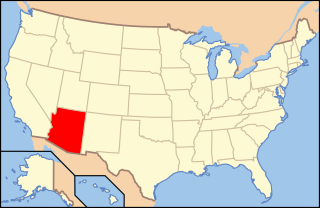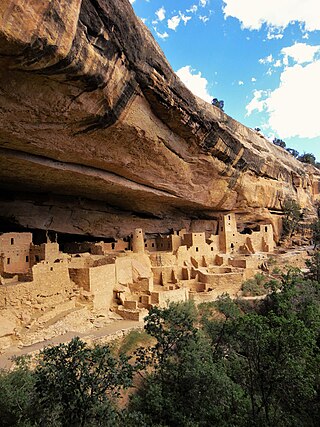
Paleontology in Arizona refers to paleontological research occurring within or conducted by people from the U.S. state of Arizona. The fossil record of Arizona dates to the Precambrian. During the Precambrian, Arizona was home to a shallow sea which was home to jellyfish and stromatolite-forming bacteria. This sea was still in place during the Cambrian period of the Paleozoic era and was home to brachiopods and trilobites, but it withdrew during the Ordovician and Silurian. The sea returned during the Devonian and was home to brachiopods, corals, and fishes. Sea levels began to rise and fall during the Carboniferous, leaving most of the state a richly vegetated coastal plain during the low spells. During the Permian, Arizona was richly vegetated but was submerged by seawater late in the period.

The Ogallala Formation is a Miocene to early Pliocene geologic formation in the central High Plains of the western United States and the location of the Ogallala Aquifer. In Nebraska and South Dakota it is also classified as the Ogallala Group. Notably, it records the North American Land Mammal Ages (NALMAs) Hemphillian, Clarendonian, and Barstovian. It also includes an excellent record of grass seeds and other plant seeds, which can be used for biostratigraphic dating within the formation. The Ogallala Formation outcrops of Lake Meredith National Recreation Area preserve fish fossils. Similar specimens from the same unit are found at Alibates Flint Quarries National Monument in Texas.

The Brule Formation was deposited between 33 and 30 million years ago, roughly the Rupelian age (Oligocene). It occurs as a subunit of the White River Formation in Nebraska, Colorado, North Dakota, South Dakota, and Wyoming.
The Cherry Canyon Formation is a geologic formation found in the Delaware Basin of southeastern New Mexico and western Texas. It contains fossils characteristic of the Guadalupian Age of the Permian Period.
The Gardener's Clay Formation is a Pleistocene geologic unit straddling the New York-New Jersey border. Fossil fish vertebrae and teeth are preserved in its sediments.
The Hannold Hill Formation is an Early Eocene (Wasatchian) geologic unit in the western United States. It preserves the fossilized remains of the ray Myliobatis and gar.

The Culpeper Basin is one of the Newark Supergroup's Triassic rift basins. It lies east of the Appalachian Mountains and extends from the Madison County—Orange County line in Virginia to Frederick, Maryland. A diverse group of sedimentary rocks including siltstone, sandstone, and conglomerate within the basin were intruded by igneous rocks, which caused thermal metamorphism at the contact with sedimentary rock.
The Pen Formation is a Campanian-age geologic unit in the western United States.
The Bell Canyon Formation is a geologic formation found in the Delaware Basin of southeastern New Mexico and western Texas. It contains fossils characteristic of the Guadalupian Age of the Permian Period.
The Doughnut Formation is an Upper Mississippian geologic unit in the western United States. Fish fossils have been discovered in shale outcrops of this formation in Dinosaur National Monument.
The Brushy Canyon Formation is a Permian geologic unit in Guadalupe Mountains National Park. The formation contains fan sandstones that were deposited under ancient seawater during the Middle Permian. These rocks contain abundant fish fossils like sharks' teeth preserved within small phosphatic nodules.
The Titus Canyon Formation is an Eocene geologic formation in California. H. Donald Curry collected the type specimens of the three teleosts Fundulus curryi, Fundulus euepis, and Cyprinodon breviradius in the Titus Canyon Formation. Both of these genera are present in the Titus Canyon Formation sediments of Death Valley National Park.
The Kishenehn Formation is a Paleogene stratigraphic unit in Montana. Fossil amiiforme and teleost fish have been found in outcrops of the formation's Coal Creek Member in Glacier National Park. Mosquitos have also been found in the Coal Creek Member, and have been found to be hematophagous. It is considered a Middle Eocene Lagerstätte.

The Cliff House Sandstone is a late Campanian stratigraphic unit comprising sandstones in the western United States.
The Glenns Ferry Formation is a Pliocene stratigraphic unit in the western United States. Outcrops of the formation in Hagerman Fossil Beds National Monument preserve the remains of seven fish species, five of which are extinct. These include the teleosteans Mylopharodon hagermanensis, Sigmopharyngodon idahoensis, and Ptychocheilus oregonensis, Ameirurus vespertinus, and the sunfish Archoplites taylori. A nearly complete skull of the catfish Ameirurus vespertinus was recovered in 2001 from the wall of the Smithsonian Horse Quarry.
The Hidden Valley Dolomite is a Silurian−Devonian geologic formation in the northern Mojave Desert of California, in the western United States.
The Fernando Formation is a Plio-Pleistocene marine mudstone, siltstone and sandstone formation in the greater Los Angeles Basin, Ventura Basin, and Santa Monica Mountains, in Los Angeles County of Southern California.
The Drake Bay Formation is a Pliocene stratigraphic unit in California. In 1993, paleontologists excavated a whale skeleton associated with fossil shark teeth and fish vertebrae that may have belonged to a giant salmon from Drake Bay sediments at Point Reyes National Seashore.
Squatirhina is a genus of Late Cretaceous cartilaginous fish whose fossils have been found in the Aguja and Pen Formations of Big Bend National Park, Texas, USA.

Burrow fossils are the remains of burrows - holes or tunnels excavated into the ground or seafloor - by animals to create a space suitable for habitation, temporary refuge, or as a byproduct of locomotion preserved in the rock record. Because burrow fossils represent the preserved byproducts of behavior rather than physical remains, they are considered a kind of trace fossil. One common kind of burrow fossil is known as Skolithos, and the similar Trypanites, Ophiomorpha and Diplocraterion.





